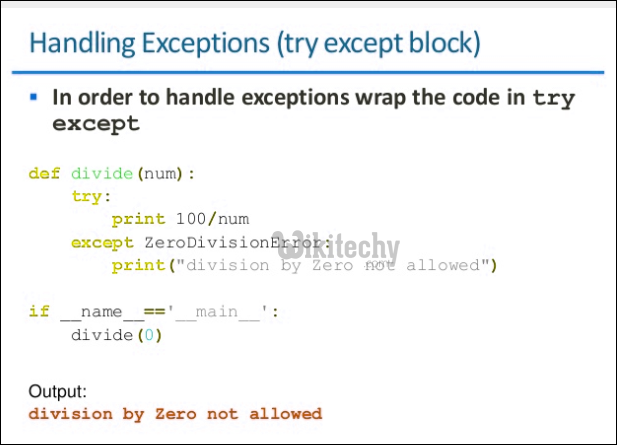

#Try except python code#
Now remove the return statement in the try block and execute the above code again. The else block never got executed because the function returned even before the execution reached the else clause. Note the return statement in the try block. So, why didn’t the else clause get executed here though the try block did not raise any exception. Usage of return with try/else/finally def test_func(): try: x = 10 print(f" Inside try block ") return x except Exception as e: x = 20 print(f" Inside except block ") return x else: print(f" Inside else block ") x = 40 return x finally: x = 30 print(f" Inside finally block ") return x print(test_func()) Output: Inside try block Inside finally block 30 This would have given an idea on the execution flow.Now that we have a good understanding of how try/except/finally works with return statements, let’s try to squeeze in another clause.Īn else clause can be added along with try/except and the else clause will get executed if the try block does not raise an exception. def test_func(): try: x = 10 print(f" Inside try block ") return x except Exception as e: x = 20 print(f" Inside except block ") return x finally: x = 30 print(f" Inside finally block ") return x print(test_func()) Output: Inside try block Inside finally block 30 To have a clearer idea of the execution flow, let’s add print statements in every block.

We should remember the fact that a finally statement gets executed ALWAYS. So, again the output value of x will be 30. Usage of return with exceptions def test_func(): try: x = 10 raise Exception except Exception as e: print(f" Raising exception ") x = 20 return x finally: x = 30 return x print(test_func()) Output: Raising exception 30 Now, what happens if an exception is raised in the aforementioned code. So as you guessed it right, the output of the above code will be 30. If a finally clause includes a return statement, the returned value will be the one from the finally clause’s return statement, not the value from the try/except clause’s return statement.If the try statement reaches a break, continue or return statement, the finally clause will execute just prior to the break, continue or return statement’s execution.The finally clause runs whether or not the try statement produces an exception. If a finallyclause is present, the finally clause will execute as the last task before the try statement completes.It’s pretty normal to make that assumption because we tend to think that the moment there is a return statement in a function, then it returns(exits) from the function.Well, that may not be true in this case. If you think the output of the above code is 10, I am afraid you are wrong. Usage of return with try/except def test_func(): try: x = 10 return x except Exception as e: x = 20 return x finally: x = 30 return x print(test_func()) Output: 30 Let’s carefully take one step at a time to understand the usage of return statements during exception handling. Well, one could easily put foot in their mouth when they use return statements with try/except/finally in Python. So what could possibly go wrong here? Why should we be cautious? except FileNotFoundError as e: print(f" Error while reading file ") finally: print(" Closing the file ") f.close() Let’s quickly get to an example of a basic try/except clause try/except statementsĪssuming the file is unavailable, executing the below code will give the output as shown below. Python defines try/except to handle exceptions and proceed with the further execution of program without interruption.

Note: For non-members, this article is available at


 0 kommentar(er)
0 kommentar(er)
